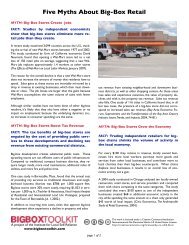Building Healthy Soils with Compost to Protect Watersheds
Building Healthy Soils with Compost to Protect Watersheds
Building Healthy Soils with Compost to Protect Watersheds
Create successful ePaper yourself
Turn your PDF publications into a flip-book with our unique Google optimized e-Paper software.
Frequently Asked Questions<br />
Q: Is compost a fertilizer? <br />
A: <strong>Compost</strong> is a soil amendment that enhances the chemical, physical, and biological <br />
characteristics of soils but is not typically characterized as a fertilizer. 80 However, because <br />
compost contains nitrogen, phosphorous, and potassium (N-‐P-‐K), Maryland’s new nutrient <br />
management regulations will likely impede amending soils <strong>with</strong> compost as a watershed <br />
protection best management practice. Under the MD Department of Agriculture revised <br />
regulations, if a product has “fertilizer value” (i.e. N-‐P-‐K) and is used on agricultural lands <br />
(including sod and turf areas), its use will be restricted. 81 While compost is more normally <br />
applied as a soil amendment than a fertilizer, it can supplement fertilizer applications <strong>to</strong> <br />
reduce the amount of synthetic fertilizer use over time. This will reduce costs and <br />
potential N and P leaching by use of synthetic fertilizer. 82<br />
Q: Can compost-‐amended soils reduce runoff or leaching of nutrients such as nitrogen (N) <br />
and phosphorous (P)? <br />
A: Yes. First, amending soils <strong>with</strong> compost adds organic matter <strong>to</strong> the soil that, unlike <br />
chemical fertilizers, facilitates a slow-‐release of nitrogen, allowing plants access <strong>to</strong> their <br />
needs, and reduces the risk of nutrient transport through leaching and runoff. This is more <br />
common in composts <strong>with</strong> higher carbon <strong>to</strong> nitrogen (C:N) ratios. 83 While compost applied <br />
at high rates, can raise P <strong>to</strong> levels that exceed the soil’s capacity <strong>to</strong> immobilze P, applying <br />
compost can also improve soil physical properties (e.g. aggregation, infiltration, water-holding<br />
capacity) that reduce runoff volume and P-‐bound eroded sediment. 84 Furthermore, <br />
while composts <strong>with</strong> high nitrate concentrations may not be desirable for use in or around <br />
surface water, research indicates that compost’s ability <strong>to</strong> reduce runoff volume results in <br />
lower nitrate losses particularly after initial rainfall events. Compared <strong>to</strong> conventional <br />
seeding and fertilizer, quality compost also typically has a lower inorganic N content (the N <br />
form more easily lost in s<strong>to</strong>rmwater runoff compared <strong>to</strong> organic N). 85<br />
This compost berm acts as a <br />
filter <strong>to</strong> remove sediment <br />
and pollutants (such as oil, <br />
grease, heavy metals, and <br />
suspended solids) from <br />
water traversing through it <br />
downstream. <strong>Compost</strong> filter <br />
berms are dikes of compost <br />
or similar compost product <br />
placed perpendicular <strong>to</strong> <br />
water flow. <br />
Pho<strong>to</strong>: Texas Commission on <br />
Environmental Quality <br />
Q: How can composting and using compost improve problems associated <strong>with</strong> raw manure <br />
such as handling and s<strong>to</strong>rage, pathogen contamination, disposal, and nutrient leaching <br />
caused by application <strong>to</strong> agricultural lands? <br />
A: <strong>Compost</strong>ing reduces the weight and moisture content of manure and kills disease <br />
causing pathogens, while producing a value-‐added product. Because composting converts <br />
the nitrogen in manure in<strong>to</strong> a more stable organic form, the finished compost is less <br />
susceptible <strong>to</strong> leaching when applied <strong>to</strong> soils. 86 There are a number of composting facilities <br />
in the Mid-‐Atlantic region that accept poultry, horse, and lives<strong>to</strong>ck manures. <br />
Q: How much compost should be incorporated in<strong>to</strong> soils <strong>to</strong> achieve a minimum soil quality <br />
and depth that can protect our watershed? <br />
A: Recommend soil amendment rates call for “a <strong>to</strong>psoil layer <strong>with</strong> a minimum organic <br />
matter content of 10% dry weight [30-‐40% compost amendment by volume] in planting <br />
beds, and 5% [15-‐25% compost amendment by volume]… in turf areas, and a pH from 6.0 <br />
<strong>to</strong> 8.0… or matching the pH of the original undisturbed soil. The <strong>to</strong>psoil layer shall have a <br />
minimum depth of eight inches…” 87<br />
Q: Are compost-‐based best management practices (BMPs) more beneficial than traditional <br />
construction and maintenance practices? <br />
A: Research has shown that compost-‐based products and practices outperform <br />
conventional methods on multiple erosion control and s<strong>to</strong>rmwater management <br />
parameters. 88<br />
Q: Is the implementation of compost-‐based soil systems more expensive than conventional <br />
construction and maintenance practices? <br />
A: Because compost products and systems provide long-‐term benefits that improve the <br />
overall health of soil and watershed ecosystems, maintenance costs can be avoided and <br />
funds repurposed. 89 Research has also indicated that up-‐front savings can be realized as <br />
well. In a study comparing the cost of compost-‐based systems versus conventional <br />
sediment control devices, all four different compost filter sock treatments (i.e. mesh tubes <br />
8 <strong>Building</strong> <strong>Healthy</strong> <strong>Soils</strong> <strong>with</strong> <strong>Compost</strong> <strong>to</strong> <strong>Protect</strong> <strong>Watersheds</strong>





